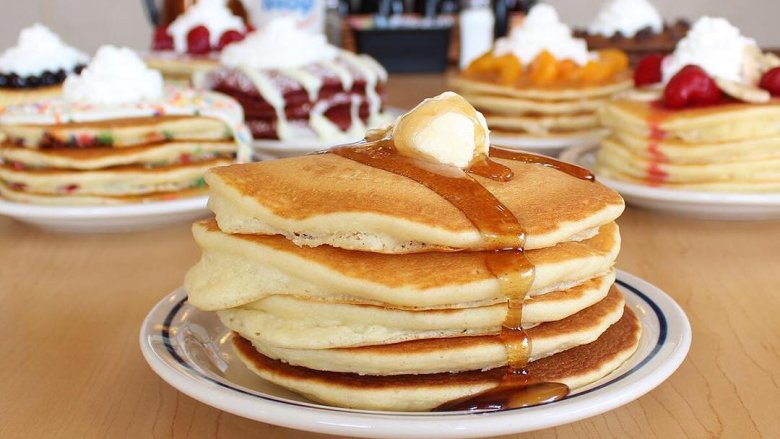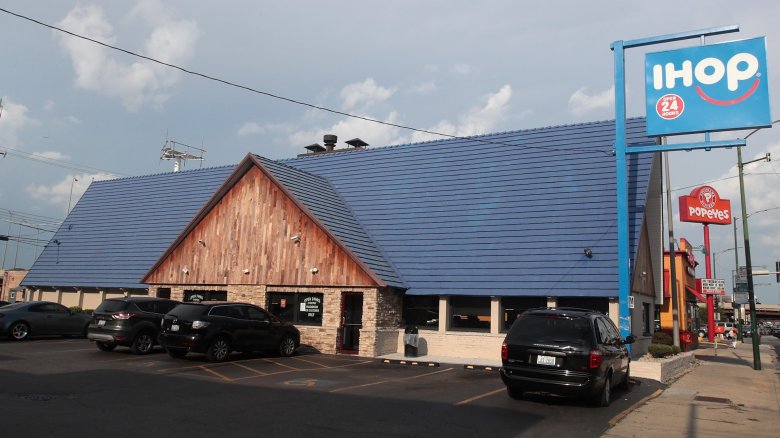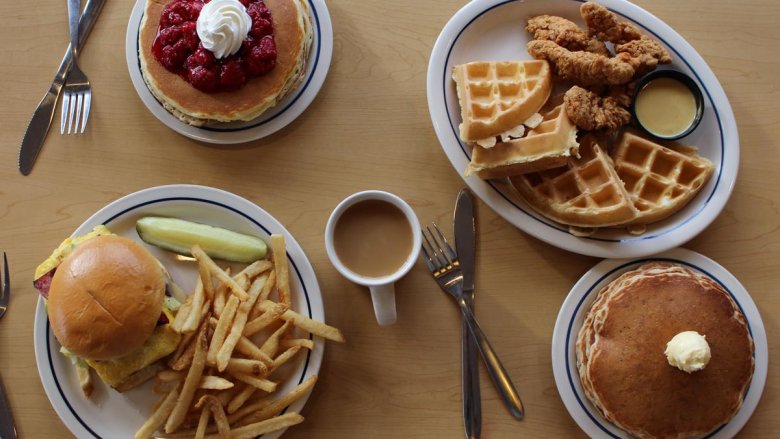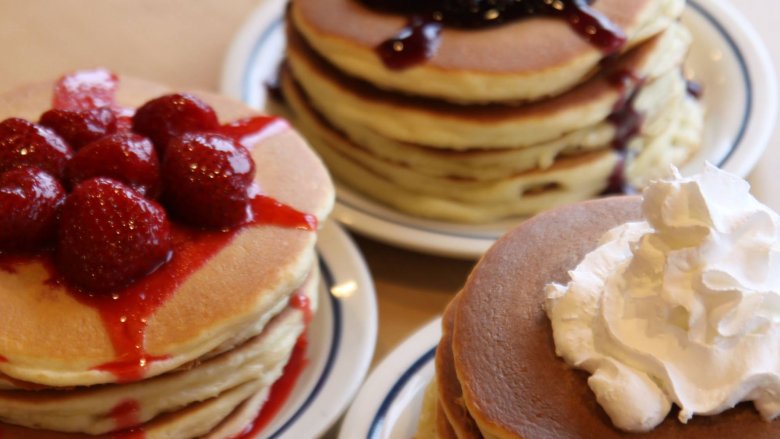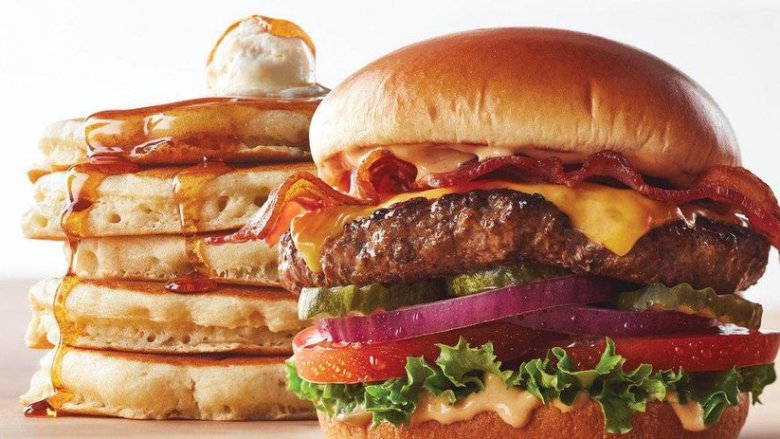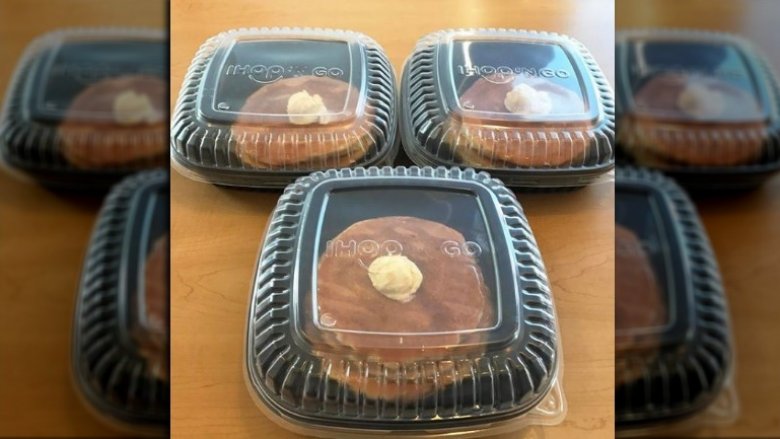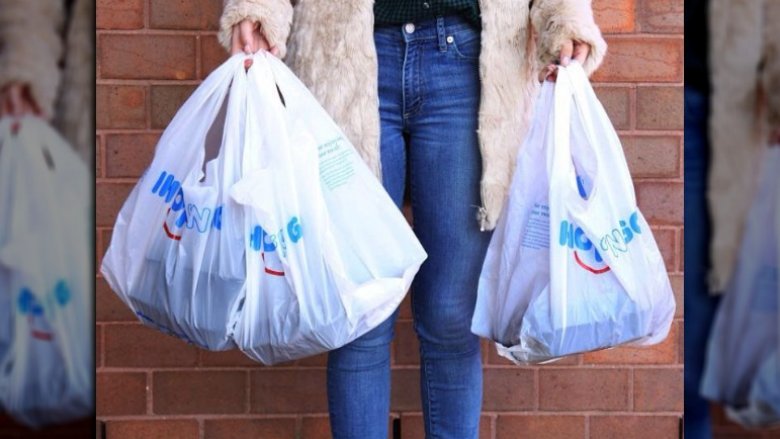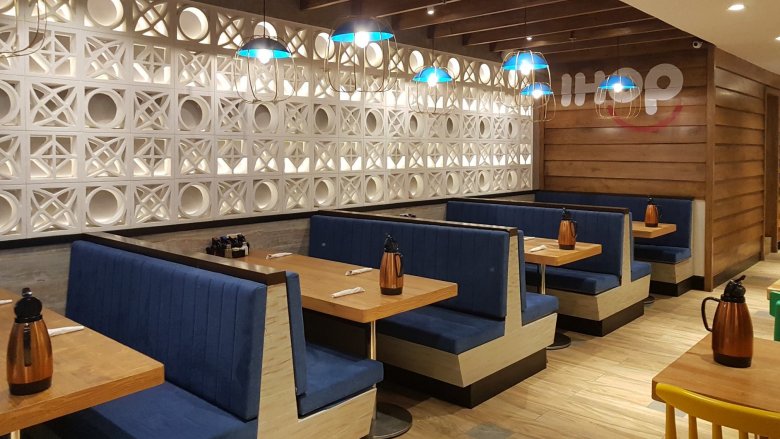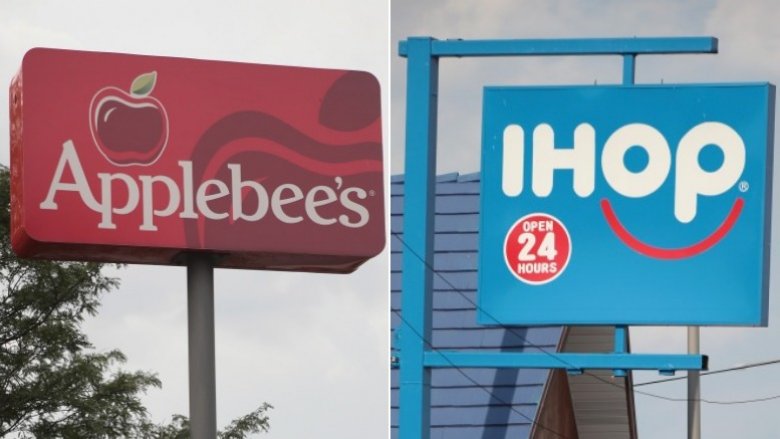The Real Reason IHOP Is Disappearing Across The Country
It wasn't so long ago that IHOP dominated the breakfast landscape. After a rocky period in the 1970s, when its corporate owner International Industries collapsed and IHOP was left out in the cold, it was saved by refocusing on family dining right as the mall was blossoming across the American landscape.
Its policy of staying open 24 hours a day, seven days a week, every single day of the year (at least at some locations), makes it a beacon for the hungry and the lonely. But we're a long, long way away from the carb-and-red-meat loving 1980s, and what was once a surefire recipe for growth has become instead a massive liability. IHOPs across the country are closing, and part of that is because the company is only slowly coming to terms with how the industry has changed. Here are all the obstacles facing what used to be one of America's most popular diners.
Casual dining is in a slump
IHOP's woes are, to some degree, common across the entire casual dining sector. The super-star of the restaurant industry lately has been fast-casual spots like Shake Shack and Chipotle, which has been the only sector of the industry to see its foot traffic go up over the last five years. And when people do sit down to place an order, they tend to want to eat local. Between 2017 and 2020, independent restaurants and small chains are expected to grow at a rate of 4 to 5 percent, double the rate of major chains. That's left almost every casual dining chain, fast food place, and even some upscale chains, battling for a shrinking customer base.
IHOP is just as exposed to these risks as anybody else, and there's not a lot they can do about it. What's trendy is changing — and it no longer includes IHOP.
People are running away from carbs
There's one uniting theme among a lot of popular diets, from Whole 30, to keto, to paleo, and that's that carbs are the enemy. That's not an environment friendly to a restaurant mostly known for pancakes and waffles. Keto fans are generally stuck with bunless burgers, and the Whole 30 crowd is mostly stuck with plain eggs and a salad. Neither of those options are enough to make anyone run to IHOP.
And that's before you consider rising numbers of vegetarian and vegans out there. While it is possible to eat vegan at IHOP, you're mostly going to be stuck with a pile of sides like hash browns and fruit cups.
True, these struggles aren't unique to IHOP; most chains aren't particularly friendly to strict diets, and it's hit some harder than others. But also, most chains aren't called the International House of Pancakes and don't offer you free pancakes on your birthday. Compared to more diet-friendly restaurants like Sweetgreen, it's tough for IHOP to compete for the dieter's dollar.
The menu is forgettable
Probably the most famous dish IHOP serves is the Rooty Tooty Fresh 'n Fruity, which is four buttermilk pancakes with a fruit and syrup topping and whipped cream. That dish is old enough to be a millennial, which should tell you how often the pancake house changes its menu. It's undeniably a judgement call to label IHOP's menu boring, and one can argue that trend-chasing would be an even worse look.
That said, take a scroll through the menu and see what you can only get at IHOP. Bar the occasional seasonal dish, it's mostly diner fare you can get from almost any place that serves breakfast. In fact, in 2015 IHOP's bold move on its menu was to cut it down from 180 items to 140. Making it worse, if you compare the old menu and new menu, you quickly find it was a lot of IHOP's attempts at healthy options that got the axe, a decision that's looking increasingly like a bad call.
The IHOb stunt did them no favors
Remember when IHOP kicked off an elaborate publicity stunt that declared they were changing their name to the International House Of Burgers, or IHOb, right down to actually changing some of their signage? It was IHOP's solution to the problem that even its loyal customers had no idea that it served lunch and dinner. It did, at least, capture the internet's attention, but whether it achieved anything beyond annoying people, is an open question.
IHOP claims they sold four times as many burgers since the stunt unfolded, but location data tracking didn't point to an increase in visits; in fact it found a slight drop among women. There were even conspiracy theories that this was nothing more than a failed rebrand. Either way, we suppose it at least did its job; people were reminded you can get a burger from IHOP. Whether that was worth the contempt of the internet and the wrath of Wendy's — not to mention all the ad dollars spent? Time will tell.
They were late with online ordering
Being able to order online to grab your food and go has been one of the key drivers of growth for restaurants in recent years. Just look at how well Starbucks did with its app, something that other chains like Dunkin' Donuts quickly imitated.
And for sit-down restaurants, which live and die on quick table turnover and increasingly a curbside takeout business, you'd think the appeal would be obvious for IHOP, especially with its presence at easy-on easy-off highway exits. Yet, it only rolled out online ordering in late 2017—along with a very late to the scene mobile app—making it the last to arrive at a party competitors like Chili's and TGI Friday's were already ruling. Making it even more unusual, sister brand Applebee's had rolled out a new app nearly a year before. They're not the only chain behind the curve here, but IHOP is starting this race with a fairly large gap behind competitors, and it's not clear if they can cross that gap quickly or efficiently.
Food delivery was even later, and it's struggling
If online ordering is a big deal in the food business, delivery is giving that some real competition. While casual dining has plunged, food delivery has exploded. The problem is that like online ordering, IHOP didn't get on the delivery train until well after it had left the station. As local places stole the hearts of users of services like GrubHub and DoorDash, IHOP just sat there and waited for diners to come sit down.
That said, delivery can be a hard sell for franchisees, who can be stuck giving 30 percent of the check to the delivery service. So perhaps it's not surprising that even when they finally made the leap, IHOP only managed to talk 300 of its 1500 or so restaurants to sign onto DoorDash. But if IHOP is going to keep flipping those pancakes, it's probably going to need to figure out how to cater to customers who don't want to put on pants to eat a short stack.
They're being accidentally killed by Amazon
Amazon is often accused of economic murder, but what it's doing to IHOP, and other casual dining chains, is entirely by accident. Online shopping is growing far faster than traditional retail, which means more people are ordering online and staying away from the mall, even on shopping holidays like Black Friday. This is good in that there are fewer brawls over cheap TVs, but it's bad for restaurants.
Foot traffic is the lifeblood of all brick-and-mortar retail, but that's particularly the case for restaurants in and around malls. Food is one of our most common impulse purchases, so if customers aren't in front of the pancakes, they're not going to start buying them. Adding to the problem is the only way to "solve" lower foot traffic is to start hiking up prices, a strategy that may work in the short term. But there's only so much you can ask for pancakes, especially when, hey, this pancake maker was only ten bucks on Amazon!
They have an apple-shaped weight dragging them down
IHOP is owned by Dine Brands, which owns another major chain as well: Applebee's. Applebee's was bought up in 2007 as an attempt to pick up a bit more grown-up dining traffic, and most of Dine Brands' problems lately have been thanks on the riblet-slinging chain. Just the latest example: One of Applebee's biggest franchisees has gone to war with Dine Brands in court to keep its restaurants during bankruptcy. Problems like that are taking away a lot of time and attention from the parent company —typically of a problematic little sibling. And that's only part of the story.
Applebee's has been struggling for quite some time, closing more stores than IHOP. While Applebee's has turned it around at the moment by following a policy of catering to stress eaters and people who want to get hammered on the cheap, the simple fact of the matter is that if Applebee's sinks, IHOP is being dragged down with it. Basically, even if IHOP does everything right, it might ultimately be taken down by your lack of interest in a Dollarita.
